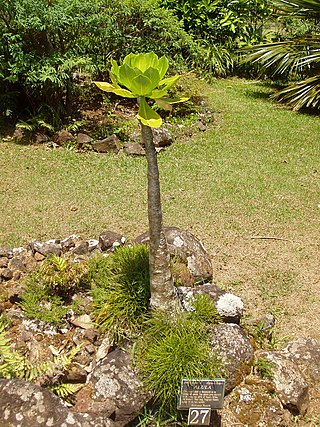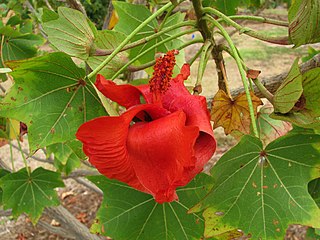Located about 2,300 miles (3,680 km) from the nearest continental shore, the Hawaiian Islands are the most isolated group of islands on the planet. The plant and animal life of the Hawaiian archipelago is the result of early, very infrequent colonizations of arriving species and the slow evolution of those species—in isolation from the rest of the world's flora and fauna—over a period of at least 5 million years. As a consequence, Hawai'i is home to a large number of endemic species. The radiation of species described by Charles Darwin in the Galapagos Islands which was critical to the formulation of his theory of evolution is far exceeded in the more isolated Hawaiian Islands.
Hawaiian hibiscus are seven species of hibiscus native to Hawaii. The yellow hibiscus is Hawaii's state flower. Most commonly grown as ornamental plants in the Hawaiian Islands are the non-native Chinese hibiscus and its numerous hybrids, though the native Hibiscus arnottianus is occasionally planted.

The National Tropical Botanical Garden (NTBG) is a Hawaii-based not-for-profit institution dedicated to tropical plant research, conservation, and education. It operates a network of botanical gardens and preserves in Hawaii and Florida.

Hibiscadelphus is a genus of flowering plants that are endemic to Hawaiʻi. It is known by the Native Hawaiians as hau kuahiwi which means "mountain Hibiscus". The Latin name Hibiscadelphus means "brother of Hibiscus". It is distinctive for its peculiar flowers, which do not fully open. Hibiscadelphus is in the family Malvaceae, subfamily Malvoideae. Several of the species in this small genus are presumed extinct, as a result of coextinction with their primary pollinators, the Hawaiian honeycreepers.

Brighamia insignis, commonly known as ʻŌlulu or Alula in Hawaiian, or colloquially as the vulcan palm or cabbage on a stick, is a species of Hawaiian lobelioid in the bellflower family, Campanulaceae. It is native to the islands of Kauaʻi and Niʻihau, but has been extinct in the wild since at least 2019-2020. This short-lived perennial species is a member of a unique endemic Hawaiian genus with only one other species.

Hibiscadelphus distans is an extremely rare species of flowering plant in the mallow family, Malvaceae, that is endemic to the island of Kauaʻi in Hawaii. It is known as hau kuahiwi in Hawaiian, which means "upland Hibiscus tiliaceus." It is a bush or small tree with heart-shaped leaves and yellow flowers and grows at between 1,000 and 1,800 feet in the remnants of native dry forests. Despite its rarity, it is believed to be the only surviving species in the genus Hibiscadelphus which is only known from Hawaii, the other five species having recently become extinct in the wild, some being known from only a single plant.

Polyscias racemosa, or false 'ohe, is a species of flowering plant in the family Araliaceae. As Munroidendron racemosum, the species was until recently considered to be the only species in the monotypic genus Munroidendron. With the change in classification, Munroidendron is now obsolete. Polyscias racemosa is endemic to the Hawaiian island of Kauai. It is very rare in the wild and some of its original habitat has been replaced by sugar cane plantations. It was thought for some time to be probably extinct, but was rediscovered a few years prior to 1967.

The Kauaʻi cave wolf spider, also known to local residents as the blind spider, is only known to occur in a few caves in a lava flow with an area of 10.5 km2 (4.1 sq mi) in the Kōloa–Poʻipū region of Kauaʻi, Hawaiian Islands, and only six populations are known to exist. While their nearest surface-dwelling relatives have large eyes, this species has completely lost its eyes. They reach a body length around 20 mm (0.8 in), and are reddish brown and completely harmless to people. Unlike most wolf spiders, it produces only 15 to 30 eggs per clutch. The female carries the egg sac in her mouthparts until the spiderlings hatch.

Trochetiopsis ebenus, the dwarf ebony or Saint Helena ebony, is a species of flowering plant that is endemic to the island of Saint Helena in the southern Atlantic Ocean. It is not related to the ebony of commerce, but is instead a member of the mallow family, Malvaceae. Saint Helena ebony is now critically endangered in the wild, being reduced to two wild individuals on a cliff, but old roots are sometimes found washed out of eroding slopes. These are collected on the island and used for inlay work, an important craft on Saint Helena. A related species, Trochetiopsis melanoxylon, is now completely extinct.

Kokia cookei is a small, deciduous tree commonly known as the kokiʻo, Molokaʻi treecotton, Cooke's kokiʻo, or Molokaʻi kokiʻo.
Hibiscadelphus crucibracteatus is an extinct species of flowering plant in the family Malvaceae that was endemic to Hawaii, on the island of Lanai.

Hibiscadelphus giffardianus is a species of flowering plant in the mallow family Malvaceae that is endemic to the Big Island of Hawaii.

Hibiscadelphus hualalaiensis is a species of flowering plant in the mallow family Malvaceae that is endemic to the Big Island of Hawaii.

Hibiscadelphus wilderianus, also known as the Maui hau kuahiwi is an extinct species of flowering plant in the family Malvaceae that was endemic to Hawaii.
Kokia kauaiensis, the Kauai treecotton or Kauaʻi Kokiʻo, is a species of flowering plant in the mallow family, Malvaceae, that is endemic to Kauaʻi, Hawaii.
Cyanea kuhihewa is a rare species of flowering plant in the bellflower family known by the common name Limahuli Valley cyanea. It is endemic to Kauai, where only two mature plants are known from a single wild population. Like other Cyanea it is known as haha in Hawaiian.
Dubautia kenwoodii, the Kalalau rim dubautia, is an "extremely rare" species of flowering plant in the family Asteraceae. It is endemic to Hawaii where it is known only from the island of Kauai. Only one plant has ever been seen: the type specimen. A part of this plant was collected in 1991 and the individual was described as a new species in 1998. It was federally listed as an endangered species of the United States in 2010. Like other Dubautia this plant is known as naʻenaʻe.

Plantago princeps is a rare species of flowering plant in the plantain family known by the common name ale. It is endemic to Hawaii, where it is known from the islands of Hawaii, Kauai, Oahu, Molokai, and Maui. Like other Hawaiian Plantago, it is known as kuahiwi laukahi, or laukahi kuahiwi. It is a federally listed endangered species of the United States.
Hibiscadelphus stellatus is a species of flowering plant in the mallow family, Malvaceae. It is called stellar hau kuahiwi in the United States Department of Agriculture PLANTS database. It is endemic to West Maui, Hawaii. It was first formally described in 2014. The specific epithet stellatus comes from the Latin for "star-shaped", referring to its stellate pubescence and the five, star-shaped involucral bracts, as well as its "beautiful and stellar (outstanding) flowers".

Cyrtandra heinrichii, known as ha'iwale or lava cyrtandra, is a perennial flowering plant in the family Gesneriaceae. It is found on the Hawaiian island of Kauai.














